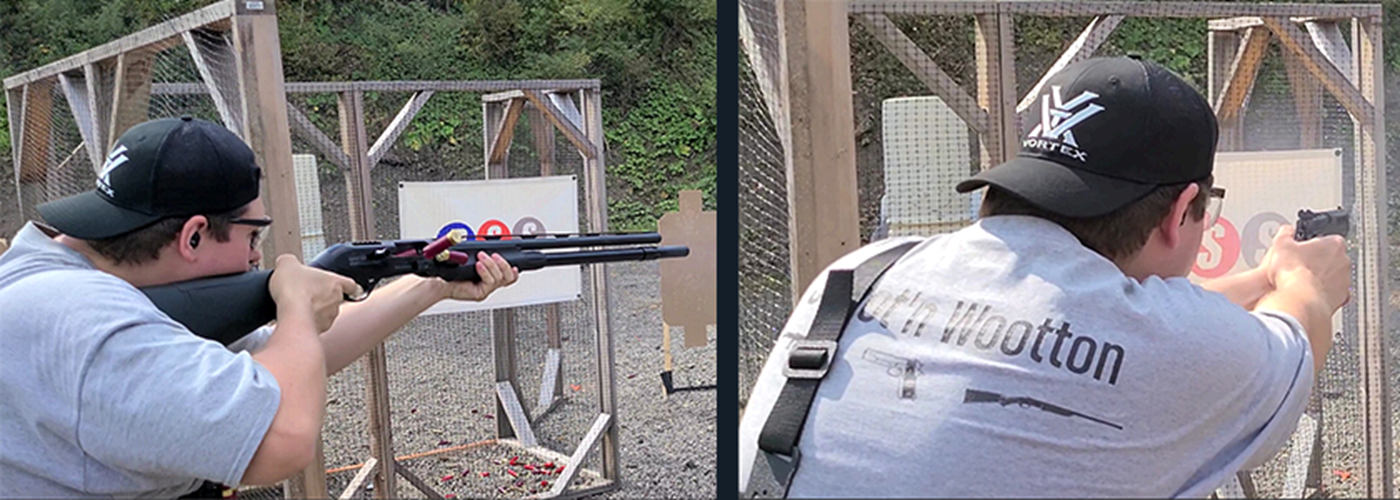
When I first heard someone refer to a “3-gun,” I had a mental picture of a handgun mounted on top of an AR via a Picatinny rail, and a sawed-off shotgun attached to the side. I had no idea that the phrase actually referred to 3-gun competition. Like most of the people in the gun community would, the person kindly explained to me what a 3-gun was.
One of the biggest obstacles for beginners who want to start learning about the gun world is how intimidating it all can be. Comfortable shooters can help grow the sport by being willing to educate and support newcomers. For you newcomers, here is a quick explanation of what a 3-gun competition is and information on how to get involved.
How 3-gun Competitions Work
The phrase “3-gun” refers to the three separate firearms used in different stages throughout the match. Each course is unique, and the designer of the match will often have some unique elements or obstacles that shooters need to navigate while going through the course.
The Guns
All 3-guns have a handgun section, a rifle section, and a shotgun section. Rules on optics and calibers vary by division, but typically a modern sporting rifle is used for the rifle section, while .14 and .12 gauge shotguns are most common in the shotgun section. There may be moving targets, field targets, flying clay pigeons, or just paper stapled to cardboard.
The Divisions
All official 3-gun competitions and most unofficial ones fall into one of three divisions: open, tactical, and heavy metal. Some matches designed for beginners may also have limits placed on the fancy equipment and toys shooters can use to gain an edge.
Open divisions allow just about anything that is legal. You’re most likely to see the hardcore shooters compete in open matches, where they can use their pistols, or heavily customized rifles and shotguns, that are impractical for anything aside from competitions. These are often the most fun to watch because of the high level of skill and dedication of the shooters.
Tactical divisions are the most common, and generally only allow a single optic. They often limit it to the rifle. Some matches allow the optic to be on the handgun or shotgun if the shooter chooses. These matches are the best to start out with, since the gear requirements are lower and they tend to be a bit more accessible.
If you’re ready to start prepping for a tactical 3-gun, learn about the right mount for an AR optic.
Heavy Metal divisions require the rifle to be .308 or larger, only 12-gauge shotguns, and .45 ACP handguns. These larger loads bring a unique element to the matches, and to make things even more interesting, only iron sights are allowed. For shooters who are just keeping their skills fresh between hunting seasons, heavy metal matches might make the most sense.
Why Participate in a 3-Gun Competition?
For participants, 3-gun matches can be as great of preparation for real-life firearm scenarios as you can get, short of going through military or law enforcement training. Hunters can keep fresh in the off-season, and hone their skills, while casual gun owners who have a few firearms, just for defensive or SHTF scenarios, can get hands-on experience.
3-gun matches are fast-paced and get your adrenaline pumping, so they can be far more helpful in developing muscle memory under pressure than any other form of training. They’re also more entertaining to watch than some other competitions because they are relatively fast and short.
How to Get Involved
Finding Matches
The best way to find unofficial matches is to ask at one of your local shooting ranges. Many local ranges host their own competitions and even if they don’t, they will likely know who does. If you want to find “official” 3-gun matches, the best sources would be 3-Gun Nation or the USPSA. You can visit their websites to see what matches are coming up.
Observe First, Participate After
This is just my recommendation, but I would say the best first step would be to just spectate a match or two before participating. It helps to understand some of the nuances behind the rules and become familiar enough with them so you don’t end up getting penalized or even disqualified because you forgot about a rule.
As you get more familiar with 3-guns through watching, you can also spend time practicing on your own to get used to moving around and quickly getting on target. If you have never quickly transitioned from handgun to rifle, or from rifle to shotgun, prior to your first match, it’s not likely to go well.
Don’t stress too much about how others in the match are going to perceive you, especially for your first couple of matches. You are here because you want to have a good time and improve your shooting skills. Everyone starts out as a beginner, and especially in a tactical division, you’re going to be surrounded by people who are hobbyists as well.
The few pro shooters out there will usually stick to open division matches, and even the pros are usually warm, welcoming, and understanding of different skill levels.
Parting Shots
If you want to get into shooting competitions, and something like a service rifle match or handgun competition doesn’t quite fit the bill for what you want, then a 3-gun might be the way to go. What I love most about 3-guns is the direct relationship with real-world use of a firearm.
If you’re carrying concealed and end up in a defensive situation, for example, the handgun portion of a 3-gun match can be great preparation for maintaining accuracy and discipline under pressure. The rifle portion can be great preparation for small or big game hunting, and the shotgun portion can be great for preparing for duck or turkey hunting.
As a nation that strongly emphasizes civilian readiness to defend our ideals and lives from any threat, it’s not surprising that we’ve embraced a competition like a 3-gun that can make a big difference in establishing that readiness.
Start preparing for your first competition today by enrolling in a local shooting class. Learn to use a new firearm or refresh your skills and accuracy with a qualified shooting instructor.
